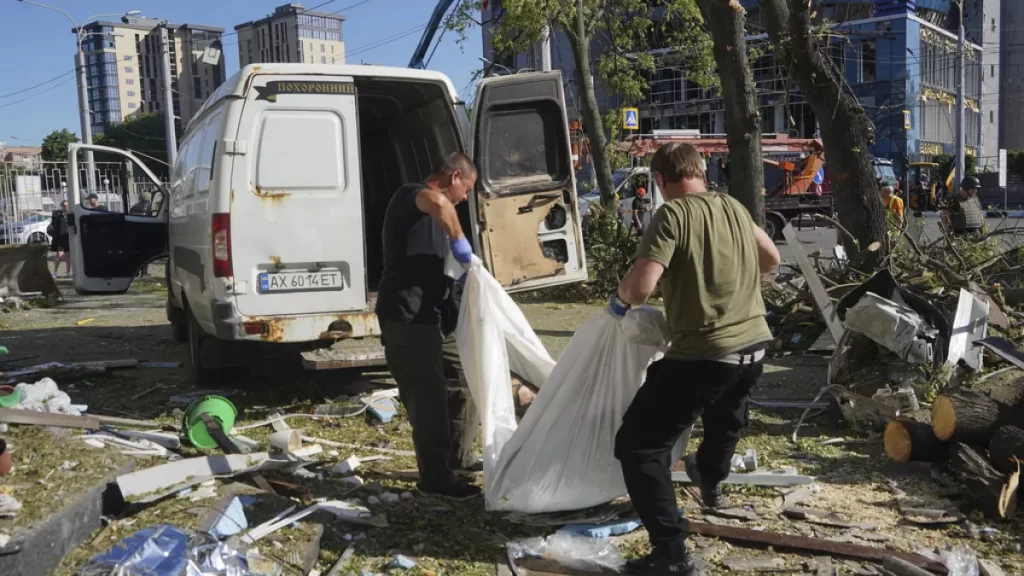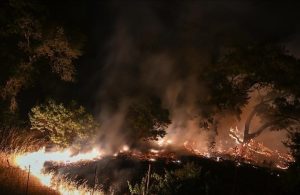Major Russian Assault Hits Ukraine, Resulting in Casualties and Infrastructure Damage
3 min read
A large-scale Russian attack across Ukraine on Monday morning has resulted in at least six deaths and significant damage to critical infrastructure, including power and water supplies. Explosions were reported in several major cities, including Kyiv, as over half of Ukraine’s regions came under assault.
The extensive air raid, involving missiles and drones, targeted cities such as Zaporizhzhia, Lutsk, Kharkiv, Zhytomyr, and Dnipropetrovsk. Russian defense officials confirmed that their strikes were aimed at Ukraine’s energy infrastructure—a persistent strategy throughout the conflict. They stated that all intended targets were successfully hit.
The barrage of attacks began late Sunday night and persisted into Monday morning, according to Ukraine’s air force. Explosions were reported from Lutsk in the west to Dnipro in the east, prompting a nationwide air raid alert and urging citizens to seek shelter.
Ukrainian President Volodymyr Zelensky reported that Russia had launched over 100 missiles and about 100 drones during this attack, describing it as one of the largest strikes to date. He highlighted the extensive damage inflicted on energy facilities and called upon Western allies, including Britain, the United States, and France, to modify their policies and permit Ukraine to use their weapons for deeper strikes into Russian territory. Currently, Ukraine is restricted from using long-range Western weapons for such purposes.
Zelensky also urged European air forces to collaborate more closely with Ukraine’s air defense systems, suggesting that this could significantly improve their ability to protect lives.
The attack affected around 15 Ukrainian regions, as reported by Prime Minister Denys Shmyhal. The weaponry used included drones, cruise missiles, and supersonic missiles. Casualties reported include:
- Two men, aged 69 and 47, were killed in the Dnipropetrovsk region. The local governor noted that a 14-year-old girl was also injured.
- A man died when his house was hit in Zaporizhzhia.
- In Lutsk, a fatality occurred at an infrastructure facility, with five others wounded and most parts of the city lacking running water.
- Izyum in Kharkiv saw one death from a missile strike.
- Zhytomyr region reported the death of a woman following strikes on residential and infrastructure sites.
- The Poltava region experienced injuries to five individuals from a hit on an industrial facility.
- The Odesa region reported seven injuries, including two children, from a separate strike.
The attacks have severely impacted Ukraine’s infrastructure, leading to widespread power outages and disruptions to water supplies. Emergency blackouts have been implemented, with energy company DTEK working to restore electricity nationwide.

Russia claimed that its attack employed high-precision, long-range air and sea-based weapons, as well as drones, in what it termed a “massive assault.” This strategy has been a continuous effort since Russia’s full-scale invasion began in February 2022, with recent months seeing intensified attacks on Ukraine’s power grid. President Zelensky had previously reported that Russia had destroyed approximately half of Ukraine’s electricity-generating capacity since late March.
To mitigate these effects, Ukraine has been importing energy from the European Union. Despite these efforts, planned nationwide blackouts are still necessary to ensure critical services like hospitals and military sites remain operational.
The Russian defense ministry stated that its strikes targeted electricity and gas facilities, as well as sites storing Western weapons, resulting in power outages and disruptions in rail transport of arms and ammunition to the front lines.
On the ground, Russian military forces have made gradual advances in the eastern regions of Ukraine. Conversely, Ukraine recently attempted a surprise offensive into Kursk, Russia, aiming to divert Russian troops from the eastern front. However, experts suggest this effort has not significantly altered the engagement dynamics.
Additionally, Ukraine reportedly attempted to strike an oil refinery in Yaroslavl, northeast of Moscow, though no casualties or damage have been reported. The Russian defense ministry also claimed to have downed nine Ukrainian drones over its Saratov region, located 560 miles from the Ukrainian border.
Andriy Yermak, President Zelensky’s chief of staff, reiterated the call for Ukraine’s allies to authorize long-range strikes on Russia with Western-supplied weapons, emphasizing the need for continued international support.







